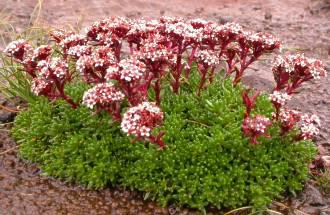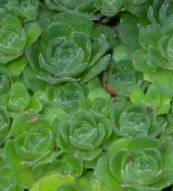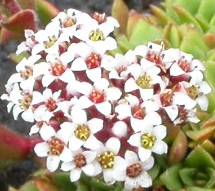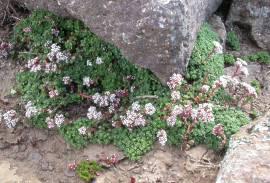Crassula setulosa
Crassula setulosa Harv.
Family: Crassulaceae
Common names: None (proposed name hairy-cushion Crassula)
Introduction
An attractive flowering dwarf cushion-succulent, drought tolerant and excellent for rockeries and living walls.

Description
Description
Crassula setulosa grows naturally as a dense mat, forming a convex cushion sometimes up to 40 cm wide and 5-10 cm high (25 cm in flower), usually in crevices and shallow soil pockets on vertical or steep rock faces. The root system is adventitious.

The species is very variable in appearance throughout its distribution especially with regard to its leaves which vary in size, shape and hairyness, but are typically 6-20 mm long and 2-10 mm wide, more often than not with a convex upper leaf surface, and tapering towards a point. Fine hairs are usually present on the upper leaf surface but hairless forms also occur. Leaves vary in colour from bright green to grey-green in the very hairy forms. The plant is highly branched giving rise to the dense mat of foliage.

Depending on the form, flowers appear in midsummer through to autumn. They are small and cup-shaped with petal tips spreading from midway up the corolla tube, usually 3 mm in diameter, and white often tinged red. They cluster to form a dense inflorescence which can be up to 15 cm high. Flowers develop into small capsules which release fine dust-like seed.
There are five recognized subspecies: C. setulosa var. setulosa, C. setulosa var.jenkinsii, C. setulosa var. deminuta, C. setulosa var. rubra and C. setulosa var. longiciliata.
Conservation Status
Status
C. setulosa var. deminuta is considered vulnerable in the 2009 Red Data listing. The other subspecies have no threat status.
Distribution and habitat
Distribution description
C. setulosa is often more prevalent at higher altitudes, particularly over 600 m, and its distribution stretches from the Eastern Cape in the south-west, being most prevalent in Lesotho (southern Drakensberg) and the northern Drakensberg mountains, and as far north as the Blouberg in the Limpopo Province.
Derivation of name and historical aspects
History
The epithet setulosa refers to the leaves being covered in small bristles.
Ecology
Ecology
Plants are usually found in rock crevices or shallow soil pockets in protected moist and shaded places on steep or vertical rock faces, and very rarely in undisturbed flat gravel areas. Growing on cliffs is an effective anti-herbivory mechanism. The geology on which they occur is varied and includes sandstone, granite, shale and basalt.
Uses
Use
There are no known uses for this plant.
Growing Crassula setulosa
Grow
Crassulas are amongst the easiest plants to cultivate and this species is no exception. They can grow in virtually any type of soil but prefer soils with half gritty sand and half fine compost. They can grow in light shade or in sunny positions and make excellent cushion plants for rockeries or living walls. They are not demanding with water but will grow faster under moister conditions. Watering should take place at least once a week but they will survive with less.
This species is grown primarily for its very dense carpet-like cushions of bright green or grey foliage which looks very appealing in a rockery or container.

Plants can live for many years and will grow to neatly occupy the available space. This species tends not to flower much in warmer climates if at all which helps to keep the plants looking neat and tidy. However, if conditions are right they will flower and may self-seed themselves and replenish themselves naturally. Like many of the closely related Sedum species in Europe, this species is also particularly well suited for use in establishing an artificial living wall. Plants do not require much water and are resilient to dry spells. They also grow in full sun and full shade making them very versatile plants and seldom die back in large patches leaving bald spots which makes them particularly suitable for living walls.
Propagation is easy from cuttings, including leaf cuttings, at any time of the year which means they can be bulked up very easily. Cuttings can be tiny and only need to have a short section of stem with a few nodes and a few leaves. Insert them into a dry gritty growing medium and water them lightly. Keep the pot in a bright situation out of direct sunlight at first. Rooting should take place within 2 weeks. Once the plants show signs of having formed roots, move them to a sunny spot, and before long young plantlets will form, forming small rosettes which will rapidly become dense cushions.
If one could ever acquire seed, this could be sown in spring. Mix the dust-like seed with a small quantity of fine sand. Spread the sand evenly over the surface of the soil which should be the same as the growing medium. Water immediately, preferably from below by standing the pot in a tray of water every few days. Keep the soil moist like this for the first month or so. Before long, tiny green plantlets should appear on the soil surface. Start to let the soil dry out between waterings. Soon the plants will bulk up and if one achieves the ideal growing conditions, one can raise many thousands of plants like this. The use of a damping-off fungicide is advisable to prevent rot.
Occasionally plants suffer from fungal infections which appear as brown blotches on their leaves. This can be treated with a fungicide and good ventilation. Otherwise, they are essentially pest free.
References
- Rowley, G. 2003. Crassula, A grower's guide. Cactus & Co. libri.
- Tolken, H. R. 1985. Crassulaceae. Flora of Southern Africa. Vol. 14. Botanical Research Institute.
Credits
Adam Harrower
Kirstenbosch National Botanical Garden
April 2011
Plant Attributes:
Plant Type: Ground Cover, Succulent
SA Distribution: Eastern Cape, KwaZulu-Natal, Limpopo
Soil type:
Flowering season: Late Summer, Autumn
PH:
Flower colour: Red, White
Aspect: Full Sun, Shade, Morning Sun (Semi Shade), Afternoon Sun (Semi Shade)
Gardening skill: Easy
Special Features:
Horticultural zones











Rate this article
Article well written and informative
Rate this plant
Is this an interesting plant?
Login to add your Comment
Back to topNot registered yet? Click here to register.